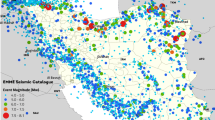Abstract
Most earthquake loss studies use an inventory approach by which the predicted damages in various categories of structures and facilities in a concerned region are estimated and added together to obtain the total estimated. Such an approach requires a detailed inventory database of the structures and facilities in the region, which is not always readily available in many regions of the world. Therefore, an alternative means of estimating earthquake losses is used based on several macroeconomic indices such as the gross domestic product (GDP) and population. Based on the published earthquake loss data during 1980–1995, the relations between GDP and earthquake losses have been formulated empirically for several intensity ranges. The world’s land surface was divided into unit cells with 0.5° × 0.5° in size, the GDP of each cell was apportioned based on its population and the GDP and population of the region to which it belongs. The predicted seismic loss of the cell was then estimated from the seismic hazard probability function, its GDP and the empirical relation between GDP and seismic loss. Accordingly, a global seismic loss map is compiled. Employing readily available social economic data as the basis for the vulnerability analysis, the method enables us to obtain seismic loss estimates for regions without a detailed inventory of exposed structures or the required collateral geological information. Seismic loss estimates can also be upgraded easily with social economic data collection for the fast developing areas of the world.
Similar content being viewed by others
References
Steinbrugge, K. V., Algermissen, S. T., Lagorio, H. J.et al.,Metropolitan Sun Francisco and Los Angeles Earthquake Loss Studies: 1980Assessment, U.S. Geological Survey Open-File Report 81–113, 1981.
Steinbrugge, K. V., Bennett, J. H., Lagorio, H. J.et al., Earthquake planning scenario for a magnitude 7.5 earthquake on the Hayward fault in the San Francisco bay area, 1987,Calif. Dept. Conservation, Sacramento, 243.
Rogers, A. M., Algermissen, S. T., Hayes, W. W.et al., A Study of Earthquakes Losses in the Salt Lake City, Utah Area, 1976, U.S.Geological Survey Open-File Report 76–89.
World Bank,World Development Report 1994:Infrastructure for Development, Oxford: Oxford University Press, 1995, 254.
United Nations,Statistical Yearbook (Thirty-eighth issue, CD-ROM), 20pp. + 1CD-ROM, New York: United Nations Publications, 1994.
Tobler, W., Deichmann, U., Gottsegen, J. et al., The Global Demography Project, Technical Report TR-95-6,National Center for Geographic In formation and Analysis, California: Univ. of California, Santa Barbara, 1995, 75.
Chen Qifu, Seismic Risk Analysis-simplified approach, Ph. D. thesis, Institute of Geophysics, State Seismological Bureau of China (in Chinese with English abstract), 1997, 93.
Dunbar, P. K., Lockridge, P. A., Whiteside, L. S., Catalog of significant earthquakes (2150 BC-1991 AD),Report SE-49, 1992,World Data Center A for Solid Earth Geophysics, September 1992.
Zhao Rongguo, Chen Yingfang, The global seismicity and earthquake disasters in 1992,Recent Developments in World Seismicity (in Chinese), 1993(4): 1.
Zhao Rongguo, Chen Yingfang, Outline of worldwide earthquakes disasters in 1993,Recent Developments in World Seismicity (in Chinese), 1994(8): 12.
Zhao Rongguo, Overview of worldwide damaging earthquakes in 1994,Recent Developments in World Seismicity (in Chinese), 1995(8): 10.
Zhao Rongguo, Overview of worldwide damaging earthquakes occurring in the half of 1995,Recent Developments in World Seismicity (in Chinese), 1995(11): 14.
Sauter, F., Shah, H. C., Studies on Earthquake Insurance, inProceeding of the Centeral American Conference on Earthquake Engineering, V2, San Salvador, El Salvador, 1987.
Akkas, N., Erdik, M., Consideration on assessment of earthquake resistance of existing buildings,Int. J. for Housing Science and Application, 1984, 8: 49.
Liu Jie, Chen Yong, Chen Linget al., A simplified approach of global seismic hazard assessment,Chinese Science Bulletin, 1998, 44(3): 246.
Author information
Authors and Affiliations
About this article
Cite this article
Chen, Q., Chen, Y., Chen, L. et al. Estimation of earthquake losses by using macroeconomic approach. Chin.Sci.Bull. 44, 199–203 (1999). https://doi.org/10.1007/BF02896272
Received:
Issue Date:
DOI: https://doi.org/10.1007/BF02896272




